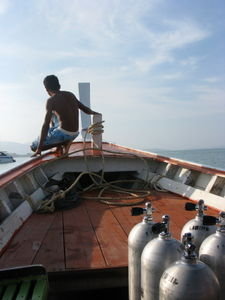Advertisement
Published: March 1st 2008

 Khao Lak Diving
Khao Lak Diving
Loading up the longtail in Khao LakI think we fell into the same trap as everybody else when Paul first asked us if we wanted to make a dive on Boonsung Wreck, this being the first time we had heard of it. While the Similans and other surrounding sites are constantly featured in write ups from magazines and reef guides, Boonsung has remained something of a mystery, except from the local guides who work here and know better. Located just a few kilometers offshore it’s simply a case of loading up the longtail, picking up some rice and curry for lunch and then heading out for the twenty minute ride to the site. Not ones for ‘mass organisation’ before diving trips Sarah and I were quickly sold and as the engine of the longtail fired up we started to get the feeling we were in for something special.
Being so close to the mainland we had already been warned that the visibility was not going to be as good as what you might find on the Similans. Since this is usually the case with wreck diving this was never going to be an issue, it was the promise of huge schools of fish, varied macro life
and the dramatic outlines of the wreck that interested us more. As we entered the water and dipped our faces I knew that the start of this dive was going to be very much the same as every other wreck dive we had made, bar few.
Since wrecks usually sit on sandy bottoms in open water you use the line as a reference so you actually find the thing, especially when visibility is low. The start of the dive begins as you look down the line and stare into oblivion. If you’ve ever had a falling dream, descending on a wreck is a very similar experience. In any case at 18 meters the wreck would soon come into sight.
In fact it was the schools of fish that ended up obstructing our vision, we sunk into a huge school of snapper that swirled round us in dizzying fashion, as the last of them trailed behind they were replaced by an even larger school of fusilier. Finally we reached the sand and began to make our first lap of the wreck. Before the Tsunami hit it was possible to identify this tin dredger that grounded around twenty years ago,
in the end force of the wave actually managed to scatter the ship into several sections making it an even more ideal homestay for the vertebrates and invertebrates that find refuge here.
In our forty minute dive we found more morays than we cared to count, ghost pipefish, sea moths, banded sea kraits, masses of lionfish and large schools of yellow tail barracuda. The wreck also acts as a nursery for young species, due to the protective nature of its structure. Juvenile Angelfish, Lionfish and Crocodile Flatheads always make interesting finds.
We surfaced with big smiles and looked round to our traditional longtail boat accompanied by our smiling captain, back dropped by the crests of the mainland hills. This is how diving began in Thailand, a few people getting together, chartering a local boat and making their own way to a local reef. Things have moved on since those days, particularly in Thailand, but it doesn’t mean we can’t find alternatives to the factory style dive companies that move their customers round like cattle.
For more information on wreck diving in Thailand, or just about any diivng in Thailand be sure to get in touch. You can find similar inspirations from our community site
for tour information to this region check .
Advertisement
Tot: 0.106s; Tpl: 0.009s; cc: 6; qc: 51; dbt: 0.0425s; 1; m:domysql w:travelblog (10.17.0.13); sld: 1;
; mem: 1.1mb

 Khao Lak Diving
Khao Lak Diving